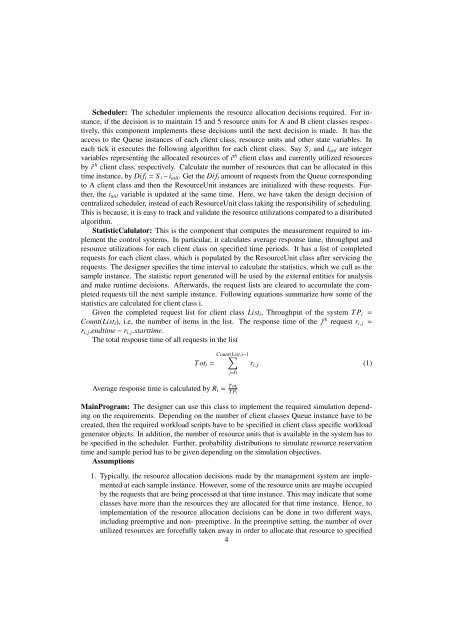A simulation model to implement multiple client class server-client ...
A simulation model to implement multiple client class server-client ...
A simulation model to implement multiple client class server-client ...
You also want an ePaper? Increase the reach of your titles
YUMPU automatically turns print PDFs into web optimized ePapers that Google loves.
Scheduler: The scheduler <strong>implement</strong>s the resource allocation decisions required. For instance,<br />
if the decision is <strong>to</strong> maintain 15 and 5 resource units for A and B <strong>client</strong> <strong>class</strong>es respectively,<br />
this component <strong>implement</strong>s these decisions until the next decision is made. It has the<br />
access <strong>to</strong> the Queue instances of each <strong>client</strong> <strong>class</strong>, resource units and other state variables. In<br />
each tick it executes the following algorithm for each <strong>client</strong> <strong>class</strong>. Say S i and i util are integer<br />
variables representing the allocated resources of i th <strong>client</strong> <strong>class</strong> and currently utilized resources<br />
by i th <strong>client</strong> <strong>class</strong>, respectively. Calculate the number of resources that can be allocated in this<br />
time instance, by Di f i = S i −i util . Get the Di f i amount of requests from the Queue corresponding<br />
<strong>to</strong> A <strong>client</strong> <strong>class</strong> and then the ResourceUnit instances are initialized with these requests. Further,<br />
the i util variable is updated at the same time. Here, we have taken the design decision of<br />
centralized scheduler, instead of each ResourceUnit <strong>class</strong> taking the responsibility of scheduling.<br />
This is because, it is easy <strong>to</strong> track and validate the resource utilizations compared <strong>to</strong> a distributed<br />
algorithm.<br />
StatisticCalula<strong>to</strong>r: This is the component that computes the measurement required <strong>to</strong> <strong>implement</strong><br />
the control systems. In particular, it calculates average response time, throughput and<br />
resource utilizations for each <strong>client</strong> <strong>class</strong> on specified time periods. It has a list of completed<br />
requests for each <strong>client</strong> <strong>class</strong>, which is populated by the ResourceUnit <strong>class</strong> after servicing the<br />
requests. The designer specifies the time interval <strong>to</strong> calculate the statistics, which we call as the<br />
sample instance. The statistic report generated will be used by the external entities for analysis<br />
and make runtime decisions. Afterwards, the request lists are cleared <strong>to</strong> accumulate the completed<br />
requests till the next sample instance. Following equations summarize how some of the<br />
statistics are calculated for <strong>client</strong> <strong>class</strong> i.<br />
Given the completed request list for <strong>client</strong> <strong>class</strong> List i , Throughput of the system T P i =<br />
Count(List i ), i.e, the number of items in the list. The response time of the j th request r i, j =<br />
r i, j .endtime − r i, j .starttime.<br />
The <strong>to</strong>tal response time of all requests in the list<br />
Tot i =<br />
Count(List ∑ i )−1<br />
j=0<br />
Average response time is calculated by R i = Tot i<br />
T P i<br />
r i, j (1)<br />
MainProgram: The designer can use this <strong>class</strong> <strong>to</strong> <strong>implement</strong> the required <strong>simulation</strong> depending<br />
on the requirements. Depending on the number of <strong>client</strong> <strong>class</strong>es Queue instance have <strong>to</strong> be<br />
created, then the required workload scripts have <strong>to</strong> be specified in <strong>client</strong> <strong>class</strong> specific workload<br />
genera<strong>to</strong>r objects. In addition, the number of resource units that is available in the system has <strong>to</strong><br />
be specified in the scheduler. Further, probability distributions <strong>to</strong> simulate resource reservation<br />
time and sample period has <strong>to</strong> be given depending on the <strong>simulation</strong> objectives.<br />
Assumptions<br />
1. Typically, the resource allocation decisions made by the management system are <strong>implement</strong>ed<br />
at each sample instance. However, some of the resource units are maybe occupied<br />
by the requests that are being processed at that time instance. This may indicate that some<br />
<strong>class</strong>es have more than the resources they are allocated for that time instance. Hence, <strong>to</strong><br />
<strong>implement</strong>ation of the resource allocation decisions can be done in two different ways,<br />
including preemptive and non- preemptive. In the preemptive setting, the number of over<br />
utilized resources are forcefully taken away in order <strong>to</strong> allocate that resource <strong>to</strong> specified<br />
4
















